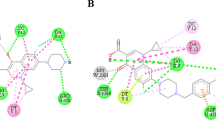Abstract
Background
Fluoroquinolones (FQs) are compounds of major interest with broad antimicrobial activities against community and hospital-acquired infections such as respiratory tract infections (nosocomial pneumonia, chronic bronchitis and tuberculosis), skin and soft tissue infections, bone and joint infections, intra-abdominal infections and sexually transmitted diseases. This broad range of activities along with favorable pharmacokinetic and low toxicity introduced this class of compounds as important antimicrobial chemotherapy agents. The rapid increase in prevalence of FQs resistant microbes in environment motivated medicinal chemists to discover new quinolone-based compounds with potent activities against Gram-positive bacteria.
Methods
The designed compounds were prepared through the two-component reaction between aromatic α-haloketones or α-halooximes and sarafloxacin in the presence of NaHCO3 in DMF, affording the corresponding N-[2-(aryl-3-yl) ethyl] piperazinyl quinolone derivatives in good yields. All synthesized compounds were evaluated for antibacterial activities against Gram-positive [Staphylococcus aureus ATCC 6538p, Micrococcus luteus, ATCC 1110, Staphylococcus epidermidis ATCC 12228 and Bacillus subtilis ATCC 6633] and Gram-negative [Escherichia coli ATCC 8739, Klebsiella pneumoniae ATCC 10031 Pseudomonas aeruginosa ATCC 9027 and Serratia marcescens PTCC 1111] bacteria.
Results
The antibacterial activities of 24 new compounds were reported as MIC values in comparison to sarafloxacin. The most active compound, 4 g, exhibited similar inhibitory activity against Gram-positive bacteria including S. aureus, S. epidermidis and B. subtilis compared to positive control. Furthermore, benzyloxime incorporated derivatives (4 s-4x) showed poor activity against all tested strains, except 4x.
Conclusion
The obtained results indicated that the synthesized compounds containing substituted piperazine moiety at the C-7 position displayed same or weak inhibitory activities compared to sarafloxacin.

ᅟ
Similar content being viewed by others
References
Hooper DC. Mechanisms of action of antimicrobials: focus on fluoroquinolones. Clin Infect Dis. 2001;32(Supplement_1):9–15.
Redgrave LS, Sutton SB, Webber MA, Piddock LJV. Fluoroquinolone resistance: mechanisms, impact on bacteria and role in evolutionary success. Trends Microbiol. 2014;22:438–45.
Bisacchi GS. Origins of the quinolone class of antibacterials: an expanded "discovery story". J Med Chem. 2015;58:4874–82.
Hernandez A, Sanchez MB, Martinez JL. Quinolone resistance: much more than predicted. Front Microbiol. 2011;2:22–7.
Hooper DC. New uses for new and old quinolones and the challenge of resistance. Clin Infect Dis. 2000;30:243–54.
Mascellino MT, Farinelli S, Iegri F, Iona E, De CS. Antimicrobial activity of fluoroquinolones and other antibiotics on 1,116 clinical gram-positive and gram-negative isolates. Drugs Exp Clin Res. 1998;24:139–51.
Petri WA, Hardman JG, Limbird LE, Gilman AG, editors. Goodman and Gilman’s the pharmacological basis of therapeutics. 10th ed. New York: McGraw-Hill; 2001. p. 1179–83.
Albrecht R. Development of antibacterial agents of the nalidixic acid type. Prog Drug Res. 1977;21:9–104.
Higgins PG, Fluit AC, Schmitz FJ. Fluoroquinolones: structure and target sites. Curr Drug Targets. 2003;4:181–90.
Correia S, Poeta P, Hebraud M, Capelo JL, Igrejas G. Mechanism of quinolone action and resistance: where do we stand. J Med Microbiol. 2017;66:551–9.
Aldred KJ, Kerns RJ, Osheroff N. Mechanism of quinolone action and resistance. Biochemistry. 2014;53:1565–74.
Hooper DC, Jacoby GA. Topoisomerase inhibitors: fluoroquinolone mechanisms of action and resistance. Cold Spring Harb Perspect Med. 2016;6:a025320.
Shen LL, Mitscher LA, Sharma PN O’ Donnell TJ, Chu DWT, Copper CS, Rosen T. Mechanism of inhibition of DNA gyrase by quinolone antibacterials: a cooperative drug-DNA binding model. Biochemistry 1989;28:3886–3894.
Odagiri T, Inagaki H, Nagamochi M, Kitamura T, Komoriya S, Takahashi A. Design, synthesis, and biological evaluation of novel 7-[(3aS,7aS)-3a-Aminohexahydropyrano[3,4-c]pyrrol-2(3H)-yl]-8-methoxyquinolines with potent antibacterial activity against respiratory pathogens. J Med Chem. 2018;61:7234–44.
Koga H, Itoh A, Murayama S, Suzue S, Irikura T. Structure-activity relationship of anti-bacterial 6,7- and 7,8-disubstituted 1-alkyl-1,4-dihydro-4-oxoquinolone-3-carboxylic acids. J Med Chem. 1980;23:1358–63.
Cooper CS, Klock PL, Chu DT, Hardy DJ, Swanson RN, Plattner JJ. Preparation and in-vitro and in-vivo evaluation of quinolones with selective activity against gram-positive organism. J Med Chem. 1992;35:1392–8.
Shafiee A, Haddad Zahmatkesh M, Mohammadhosseini N, Khalafy J, Emami S, Moshafi MH, et al. Synthesis and in-vitro antibacterial activity of N-piperazinyl quinolone derivatives with 5-chloro-2-thienyl group. Daru J Pharm Sci. 2008;16:189–95.
Letafat BS, Emami S, Mohammadhosseini N, Faramarzi MA, Samadi N, Shafiee A, et al. Synthesis and antibacterial activity of new N-[2-(thiophen-3-yl)ethyl]piperazinyl quinolones. Chem Pharm Bull. 2007;55:894–8.
Foroumadi A, Mohammadhosseini N, Emami S, Letafat B, Faramarzi MA, Samadi N, et al. Synthesis and antibacterial activity of new 7-piperazinyl-quinolones containing a functionalized 2-(furan-3-yl)ethyl. Arch Pharm Chem. Life Sci. 2007;340:47–52.
Foroumadi A, Emami S, Mansouri S, Javidnia A, Saeid-Adeli N, Shirazi FH, et al. Synthesis and antibacterial activity of levofloxacin derivatives with certain bulky residues on piperazine rings. Eur J Med Chem. 2007;42:985–92.
Emami S, Foroumadi A, Faramarzi MA, Samadi N. Synthesis and antibacterial activity of quinolone-based compounds containing a coumarin moiety. Arch Pharm Chem Life Sci. 2008;341:42–8.
Shafiee A, Emami S, Ghodsi S, Najjari S, Sorkhi M, Samadi N, et al. Synthesis and antibacterial activity of N-[2-(2-naphthyl)ethyl] piperazinyl quinolones. J Iran Chem Soc. 2009;6:325–33.
Jazayeri S, Moshafi MH, Firoozpour L, Emami S, Rajabalian S, Haddad M, et al. Synthesis and antibacterial activity of nitroaryl thiadiazole-gatifloxacin hybrids. Eur J Med Chem. 2009;44:1205–9.
Foroumadi A, Emami S, Mehni M, Moshafi MH, Shafiee A. Synthesis and antibacterial activity of N-[2-(5-bromothiophen-2-yl)-2-oxoethyl] and N-[(2-5-bromothiophen-2-yl)-2-oximinoethyl] derivatives of piperazinyl quinolones. Bioorg Med Chem Lett. 2005;15:4536–9.
Foroumadi A, Oboudiat M, Emami S, Karimollah A, Saghaee L, Moshafi MH, et al. Synthesis and antibacterial activity of N-[2-[5-(methylthio) thiophen-2-yl]-2-oxoethyl] and N-[2-[5-(methylthio) thiophen-2-yl]-2-(oxyimino) ethyl] piperazinylquinolone derivatives. Bioorg Med Chem. 2006;14:3421–7.
Baron EJ, Finegold SM. Bailey Scott’s diagnostic microbiology. 11th ed. St. Louis: CV Mosby Company; 2002. p. 235–6.
Acknowledgments
The authors declare no conflict of interests. This work was supported by a grant from the Iranian National Science Foundation (INSF); Grant no. 93023097.
Author information
Authors and Affiliations
Corresponding author
Rights and permissions
About this article
Cite this article
Asadipour, A., Moshafi, M.H., Khosravani, L. et al. N-substituted piperazinyl sarafloxacin derivatives: synthesis and in vitro antibacterial evaluation. DARU J Pharm Sci 26, 199–207 (2018). https://doi.org/10.1007/s40199-018-0226-0
Received:
Accepted:
Published:
Issue Date:
DOI: https://doi.org/10.1007/s40199-018-0226-0




